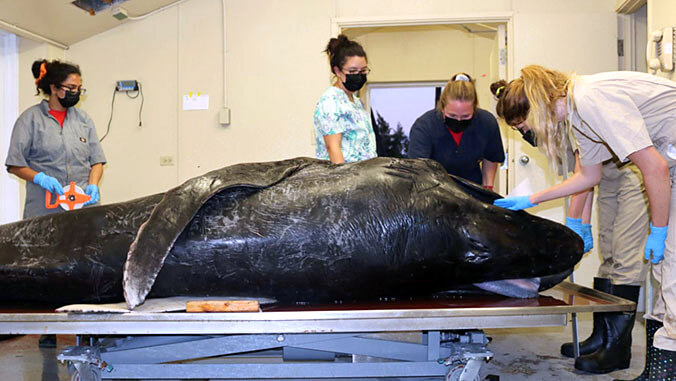
In response to a dead humpback whale calf near the Wailupe peninsula on Oʻahu, the National Oceanic and Atmospheric Administration (NOAA) worked together with the University of Hawaiʻi at Mānoa, the Hawaii Marine Animal Response, and Native Hawaiian practitioners to remove the approximately 12-foot-long carcass from the reef flat on February 6.
UH Mānoa’s Hawaiʻi Institute of Marine Biology (HIMB) team transported the carcass to the Health and Stranding Lab for a postmortem exam. The lab determined the calf was a male, less than one week old, and had evidence of nursing. The most significant postmortem finding was clear evidence of traumatic brain injury, which may have been caused by an impact of concussive force.
“Stranding investigations provide the only means to determine causes of mortality in Hawaiʻi’s dolphins and whales,” said Kristi West, an associate researcher at HIMB. “Humpback whales are special to the people of Hawaiʻi, and understanding why this animal died is foundational to protecting humpback whales while they winter in our waters.”

While the calf may have been injured by another whale, the concussive force was more likely caused by a vessel strike, also referred to as a ship strike. A vessel strike is a collision between a boat and a marine animal in the ocean. Vessels of any size and type can strike and kill or injure marine life.
Vessel-whale collisions occur every year in Hawaiʻi and are a serious risk to boaters and whales. Thousands of humpback whales migrate to the Hawaiian Islands in the winter months to breed, give birth and nurse their young. Humpback whales, particularly calves, are challenging for vessel operators to see. They spend most or all of their time underwater and generally have a low profile when surfacing to breathe. The whale may not be able to detect a vessel, nor move out of the way of an approaching vessel.
“Studying ocean health is a priority of the Hawaiʻi Institute of Marine Biology,” said Eleanor Sterling, director of HIMB. “Marine mammals are recognized sentinels of ocean health and serve as key indicator species.”
This event is an example of UH Mānoa’s goal of Excellence in Research: Advancing the Research and Creative Work Enterprise (PDF), one of four goals identified in the 2015–25 Strategic Plan (PDF), updated in December 2020.

